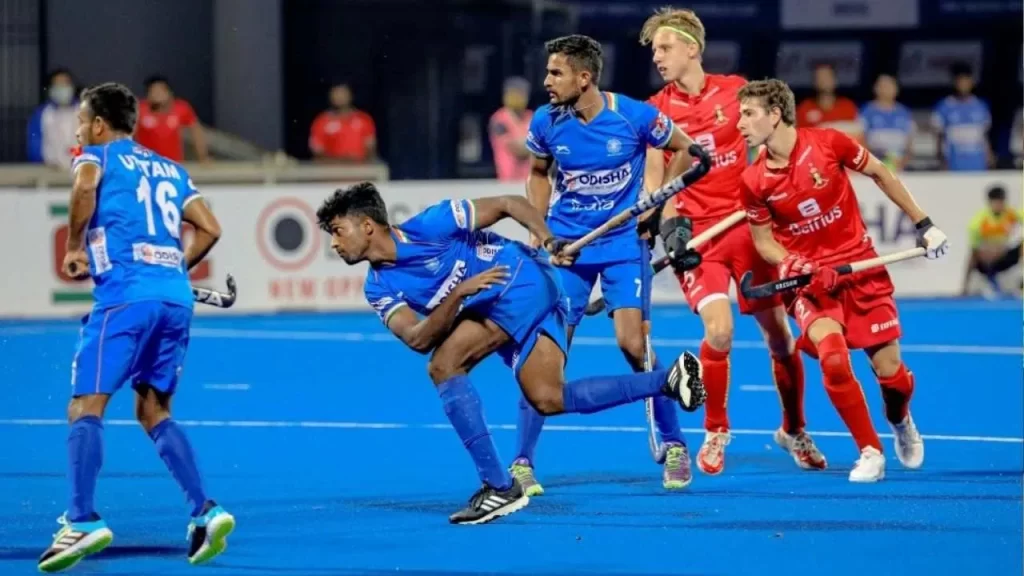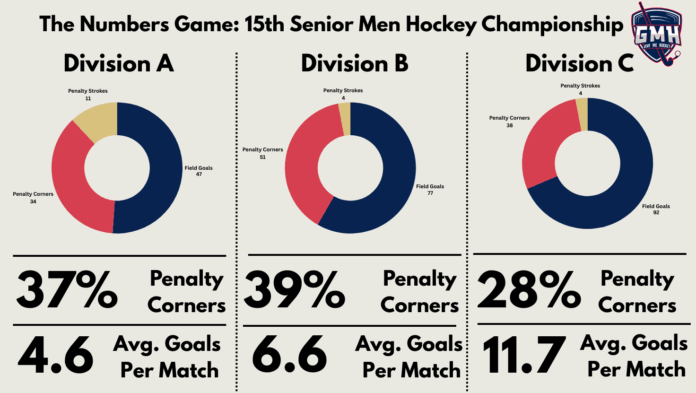Hockey Punjab reclaimed the Senior Men’s National Championship defeating Hockey Madhya Pradesh 4–1 in the finals. Punjab who last won in 2013 were helped by a brace from penalty corner expert Jugraj Singh. Uttar Pradesh Hockey secured the bronze medal with a 5–1 win over Hockey Manipur in the third-place match.
This edition marked a major shift in format, as it was the first time the men’s national championship followed a divisional system. Based on past performances, 30 teams were split into three divisions, with promotion and relegation set to be implemented.
As expected, the championship delivered plenty of action—and plenty of goals. Let’s break it down, by the numbers.
Numbers That Defined the National Championships
Participating Teams: 30
Total Matches Played: 52
Goals Scored: 358
Average Goals per Game: 6.88
Most Goals Scored in a Match: Hockey Arunachal 20-0 Tripura Hockey
Why the New Format?
For years, fans and experts have questioned the quality gap between teams in the national championships. It wasn’t unusual to see games with 20-goal margins, highlighting the disparity in skill levels. To address this issue, Hockey India introduced a divisional format—to create more balanced competition and a structured path for development.
| Divisions | Matches | Goals | Avg Goals |
|---|---|---|---|
| A | 20 | 92 | 4.6 |
| B | 20 | 132 | 6.6 |
| C | 12 | 134 | 11.1 |
The above data clearly highlights the gap in quality between divisions. In Division C, teams engaged in a goal-fest with lot of one sided games. A total of 134 goals were scored, averaging 11.17 goals per game. Whereas, the number is quite low in Division B and Division A. This new divisional format is expected to help selectors and scouts assess talent more effectively across varying competition levels.
| Attribute | Division A | Division B | Division C |
|---|---|---|---|
| Most Goals Scored | Punjab & Uttar Pradesh | Hockey Chandigarh | Hockey Chhattisgarh |
| Most Goals Conceded | Hockey Jharkhand | Hockey Andhra Pradesh | Tripura Hockey |
| Top Goalscorer | Sharda Nand Tiwari | Yogember Rawat | Harsh |
Team Performance
Looking at the team performances across divisions, both Hockey Punjab and Uttar Pradesh Hockey scored 16 goals in Division A. In Division B, Hockey Chandigarh netted 28 goals. While Hockey Chhattisgarh had the highest goal tally in division C, scoring 27 goals.
On the defensive side, Tripura Hockey conceded an astounding 44 goals in Division C—the most by any team. In Division B, Hockey Andhra Pradesh allowed 31 goals whereas Hockey Jharkhand conceded 13 in Division A.
Read More: India Women’s Hockey Team Tour of Australia: Full Squad and Match Schedule
Goal Machines of the Championship

On the individual front, Indian international Sharda Nand Tiwari of Uttar Pradesh Hockey emerged as the tournament’s top scorer with six goals in Division A. Following him closely was Hockey Punjab’s Jugraj Singh, who netted five. Yogember Rawat of Delhi Hockey led the charts with nine goals—eight of them from penalty corners in Division B. Harsh from Hockey Himachal Pradesh was top scorer from Division C with 9 goals.
Field goals remained the hallmark of the Senior Men’s Championship, accounting for 60% of all goals scored. Penalty corners goals contributed 35%, whereas 5% of goals came from penalty strokes. Notably, Division A showed a more balanced spread, with 51% of goals coming from open play and 37% from penalty corners.
Promotion & Relegation
In the next edition of the National Championships, Hockey Chandigarh and Delhi Hockey will move up to Division A. The Hockey Association of Odisha and Hockey Jharkhand will drop to Division B. While from Division C, Chhattisgarh Hockey and Hockey Arunachal will be promoted to Division B.
The 15th edition of the Senior Men’s National Championship marked the beginning of a more structured future for domestic hockey. With the new divisional format, the tournament has taken a solid step toward competitive balance, smarter scouting, and more meaningful games. One thing’s clear—the national championships just got a whole lot more interesting.





